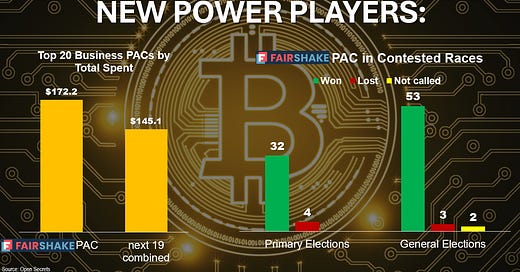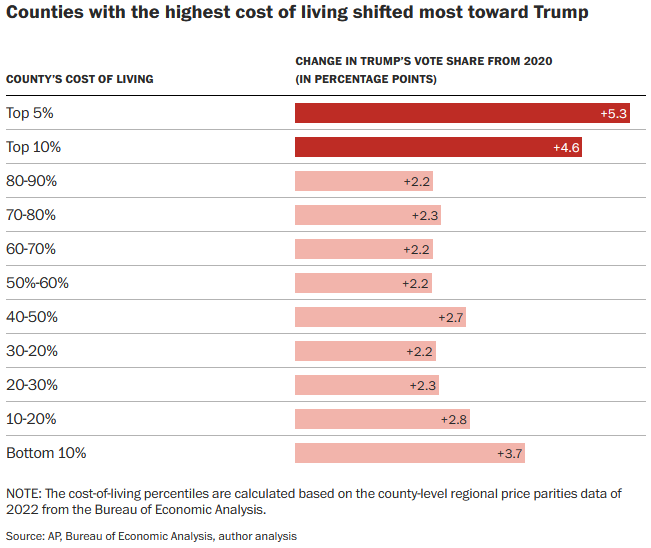Six-Chart Sunday (#43) – The New Gilded Age Revisited
6 Infographics from the week + 1 Video (Senator-Elect Dave McCormick)
In 2017 I wrote “Navigating the New Gilded Age: Why Change Is Coming… Again,” arguing that today’s fraught politics, like those of 120 years ago, are downstream of accelerating technological, cultural & economic changes (immigration; globalization; disruptive innovation; increasing inequality). Then as now, these sweeping transformations lead to frequent change elections, greater voter participation, party realignment & the rise of new power players. Today’s six charts catalogue the echoes evident in last week’s election, the first non-consecutive re-election of a President since 1892.
Voters Demanding Change, Election After Election: 2024 was the 6th consecutive change election in a row, and 9th out of the past 10 in which the party controlling the House, Senate and/or White House got ousted. 6-in-a-row is a new record. 9-out-of-10 only happened once before: the Gilded Age’s 1878-1896.
Historically-High Political Engagement: When they’ve finished counting all the votes, the 2024 election will likely show the second highest voter turnout since the early 20th century, when Gilded Age excesses bred heightened political participation and catalyzed Progressive Era reform movements. Only 2020 was higher due to aggressive measures taken to ease voting amidst the COVID pandemic.
Party Realignment: Just as the economic upheavals & accelerating globalization of the late 19th century gave rise to populism, protectionism & party realignment, the 2024 election suggests a new realignment occurring as the GOP transforms into a multi-ethnic working class party. (Recommended readings: Karl Rove’s “The Triumph of William McKinley: Why the Election of 1896 Still Matters”; Patrick Ruffini’s “Party of the People: Inside the Multiracial Populist Coalition Remaking the GOP”).
Inflation Remains Electoral Poison: In 2024, according to John Lettieri, president of the Economic Innovation Group, “the places that shifted the hardest to Trump were the largest, most expensive places.” As Noah Smith brilliantly shows, “Americans hate inflation more than they hate unemployment.” Fear of inflation also (partially) explains William Jennings Bryan’s loss to McKinley, as Bryan’s bimetalist platform — “you shall not crucify mankind upon a cross of gold” — was feared as inflationary.
New Power Players: In the Gilded Age new industrialists reshaped the global economy & remade politics. In 2024 it’s innovators & investors, whether Elon Musk through X or the crypto industry. Fairshake, the leading crypto industry PAC, spent more on elections than the next 19 biggest business PACs combined. And Fairshake won in 89% of the contested primaries and 91% of the contested general election campaigns in which it invested.
Wildest Data Point from My 2024 Election Analysis: Reaching back further than the Gilded Age for this one! In the 119th Congress, the margin of control between Republicans & Democrats will be in the single digits (likely 9, 7 or 5, depending on a few uncalled races.) This is the third Congress in a row with a single digit margin in the House. The last time that was true? 1795. The first, second & third Congresses of the U.S. also each had single digit margins, albeit with only 65, 69 & 105 total Members respectively since there were only 15 states! (Chart below *only* shows past 100 years, when there wasn’t a single digit margin even twice in a row.)
VIDEO
I had a chance last year to visit with my friend, now Senator-Elect Dave McCormick, to discuss his terrific book “Superpower in Peril: A Battle Plan to Renew America,” a few months before he launched his successful campaign. It’s an important book raising timely issues sure to animate Senator McCormick’s work over the next six years.










Query: is it possible to correlate election results with inflation rate? The one election where inflation was probably a big issue is 1980? I’m asking because the inflation rate in 2024 was not high.